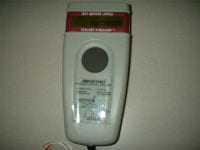 Pet Microchip Identification
Pet Microchip Identification
The sterile transporter injection system consists of a sterile applicator with a preloaded sterile implantable transponder. The transponder is indicated for permanent animal identification.
Transponders are passive devices that do not contain a battery and remain inactive except when scanned. The transponder’s circuitry is energized by a low power radio signal sent by a compatible scanner. The transponder sends the identification number as a radio signal back to the scanner, which then display the unique 15 digit identification number on the scanner.
Each transponder is pre-programmed with a unique identification number. This unique identification number is encoded during the manufacturing process. Once the number is encoded, it is impossible to altar.
Pet Microchip Reader
Sadly, once a pet is lost, the odds are against her finding her way home again. To give your pet the best chance to be identified, no matter how far he roams, have him implanted with a microchip.
The veterinarian injects a tiny computer chip—about the size of a grain of rice—just under your pet’s skin, between the shoulder blades. Then the number on the computer chip is entered in an international database, like the Central Animal Registry or PETtrac Home again. If your dog or cat is found, any animal hospital, shelter, or humane society can use a microchip reader to read the unique ID number contained on the chip. The veterinarian or worker then calls the database, or accesses it on the computer, and enters the number given off by the microchip. The database matches the number to your name and phone number. The chip can’t be lost or damaged, and it lasts for the pet’s lifetime.


 718-822-3309
718-822-3309 718-822-1802
718-822-1802


